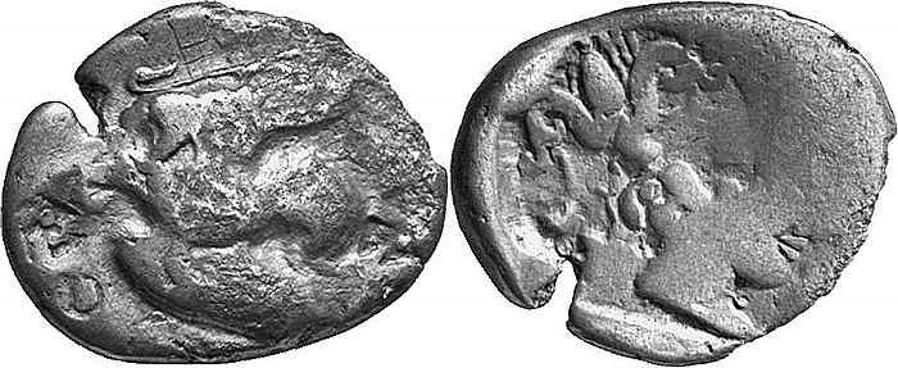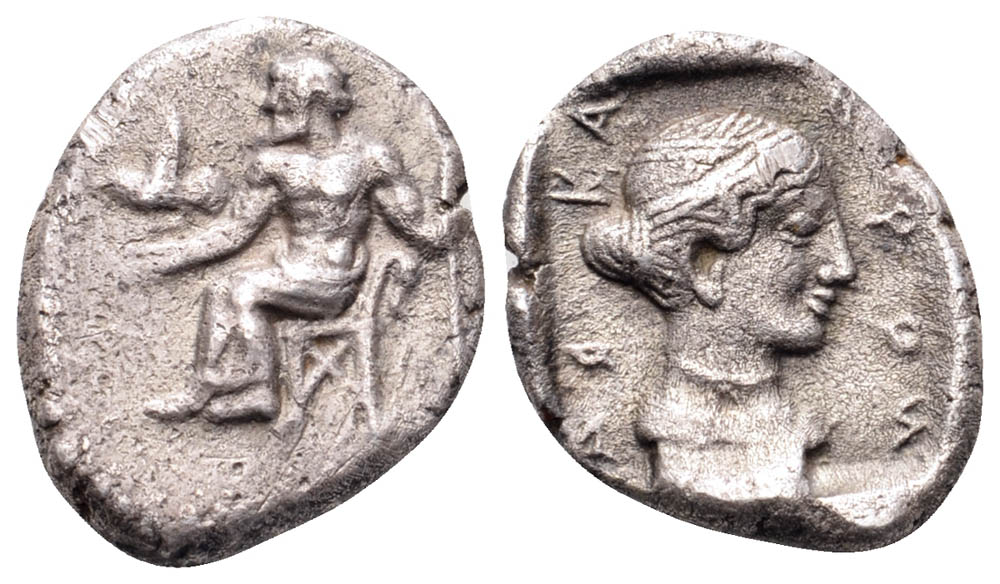1872 - Elis (hemidrachm eagle/thunderbolt) over Tegea (Zeus/Callisto) (Leu Numismatik, 90, May 2004, 13)
From SILVER
470 BCE - 460 BCE
Images
Overstriking coin

SO 12 - Elis over Tegea?.jpg [1]
Location/history
| Sale(s)Sale(s) ᵖ: | Coin Galleries, 14 Nov. 1984, 322 = Leu Numismatik, 90, 10 May 2004, 13 | |
Overstriking coin
Description
| ObverseInscription or printing placed on the obverse.: | Eagle left. | ReverseInscription or printing placed on the reverse.: | Thunderbolt within incuse circle. |
Mint and issuing power
| MintIdentifies the place of manufacture or issue of a numismatic object.: | Elis | Ancient regionAncient region. | Peloponnesus | Modern countryModern country: Greece | AuthorityIdentifies the issuing power. The authority can be "pretended" when the name or the portrait of X is on the coin but he/she was not the issuing power. It can also be "uncertain" when there is no mention of X on the coin but he/she was the issuing power according to the historical sources: |
Chronology
| FromIdentifies the initial date in a range assigned in a numismatic context. 470 BCE toIdentifies the final date in a range assigned in a numismatic context.. 460 BCE | Classical 480-323 BC |
Physical description
| MetalThe physical material (usually metal) from which an object is made.: Silver |
WeightWeight of the numismatic object (in grams). in grams: 2.52.5 g <br />2,500 mg <br /> | DenominationTerm indicating the value of a numismatic object. Examples: tetradrachm, chalkous, denarius.: hemidrachm |
AxisDescribes the directional relationship between the obverse and reverse of a numismatic object.: 1111 mm <br />1.1 cm <br /> |
| StandardStandard.: Aeginetic | |||
References
| Coin referenceReference of the Coin: | Coin series referenceReference to coin series study: | HGC 51HGC 5, n° 420, 422-423 | |
| Coin series web referenceCoin series web references: | |||
Overstruck type
Description
| ObverseInscription or printing placed on the obverse.: | Zeus Lykaios seated left, holding sceptre, eagle flying left from his hand | ReverseInscription or printing placed on the reverse.: | (Greek) Head of Kallisto right, wearing tainia, within incuse square |
Mint and issuing power
| MintIdentifies the place of manufacture or issue of a numismatic object. ᵖ: | Tegea | Ancient regionAncient region. ᵖ | Peloponnesus | Modern countryModern country: Greece | AuthorityIdentifies the authority in whose name (explicitly or implicitly) a numismatic object was issued. ᵖ: | Arcadian league |
Chronology
| FromIdentifies the initial date in a range assigned in a numismatic context. 477 BCE toIdentifies the final date in a range assigned in a numismatic context.. 468 BCE | Classical 480-323 BC |
Physical description
| DenominationTerm indicating the value of a numismatic object. Examples: tetradrachm, chalkous, denarius. ᵖ: | hemidrachm |
References
| Coin type referenceReference to coin series study ᵖ: | Williams 19652Williams 1965, n° 86, HGC 51HGC 5, n° 1041 | ||
| Coin series web reference overstruckCoin series web references overstruck: | |||
Additional data
| Frequency of overstrikesFrequency of overstrikes: | exceptional | Level of confidenceLevel of confidence of the identification: | strong |
| RemarksRemarks: | This is a coin of considerable numismatic importance! The Elean hemidrachm was struck soon after the coinage of Olympia began, but utilized a slightly earlier issue of the Arcadian League as a flan. While a number of Elean coins are known overstruck on issues from other mints, especially Aegina but sometimes from Boeotia, most of the undertypes are rarely closely datable. This piece is almost certainly R.T. Williams, The Confederate Coinage of the Arcadians in the Fifth Century B.C. ANSNNM 155 (1965), 86, ascribed to the mint of Tegea and struck c. 477-468. The goose-necked back of Zeus’ throne is visible above the eagle’s upper wing on the obverse, and the diagnostic lower profile of the head of the Arcadian goddess (Williams die R. 53) is visible below the thunderbolt on the reverse | ||
References
- a b Hoover, Oliver D. (2011), Handbook of Greek Coins 5. Coins of the Peloponnesos, Achaia, Phleiasia, Sikyonia, Elis, Triphylia, Messenia, Lakonia, Argolis, and Arkadia, Sixth to First Centuries BC, Lancaster (PA), 2011.
- ^ Williams, Roderick T. (1965), The Confederate Coinage of the Arcadians in the Fifth Century B.C. ANSNNM 155, New York, xix, 141, xiv p.
